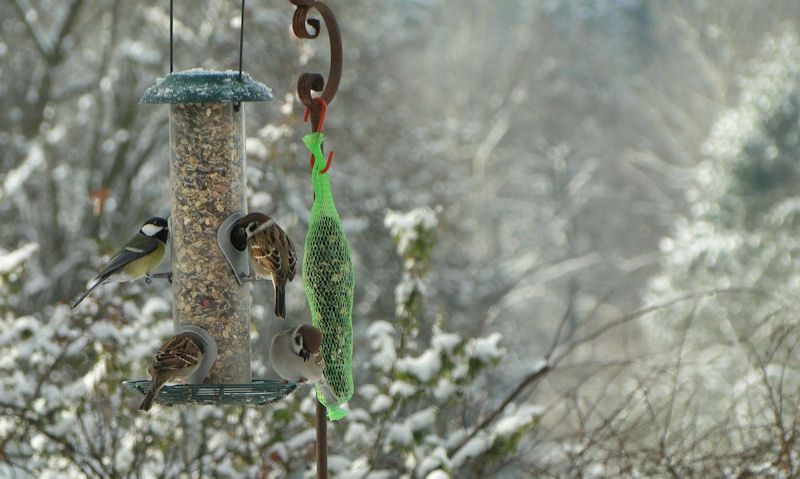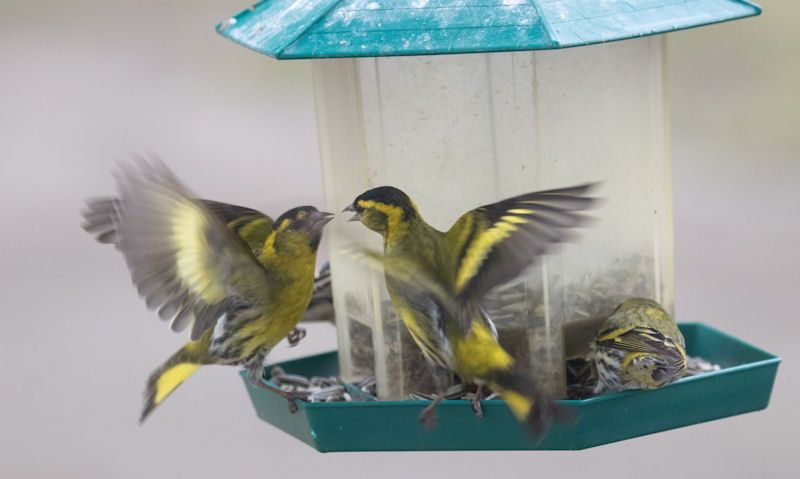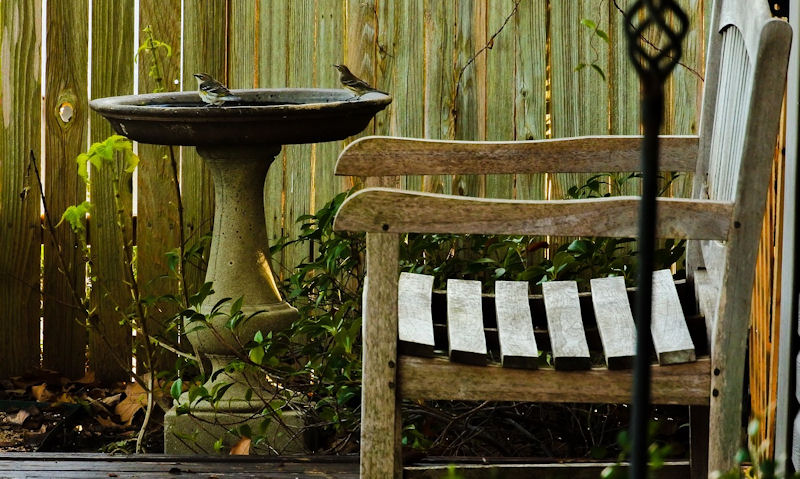Best bird feeders guide
Our best bird feeders guide covers all types of feeders you can get for your garden, are designed to attract a wide range of species for only garden birds that eat on feeders.
Top thirteen list of best bird feeders puts the feeding station on a pole the most reliable solution, following by a feeder for; peanuts, fat balls and seeds. With the best feeders including the mesh tray, ground feeder, feeders for mealworms and the window feeder for small birds.
We've identified up to thirteen types of bird feeders which we've listed from best to worse; including those that never get used to suitability issues.
And well our recommendations are solid, take into consideration the types of birds that visit your garden, because they're unlikely to suddenly attract new species.
With that in mind, setting up the best possible bird feeder should accommodate all types of birds - small or large - and be suitable to hold there favourite foods.
Well the top bird feeders hold peanuts, seeds, fat balls and mealworms, remember there're an assortment of feeders that are designed to hold a multitude of feed at one time; namely feed trays, ground feeders and wooden bird tables.
Its now over to you, remember bird feeder placement is important, so is the quality of feed you use. Don't position feeders where predators can attack, and try to locate the feeder where you can see the birds feeding from you window.
1) All-in-one feeding station
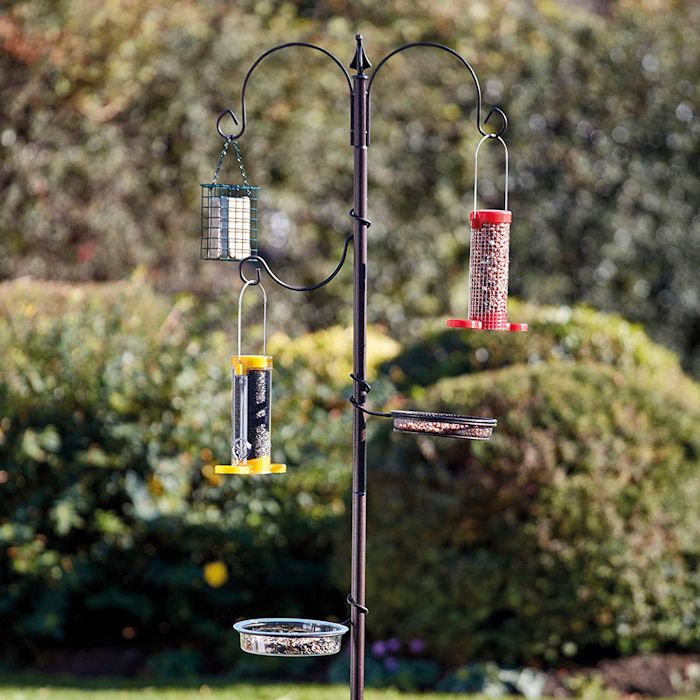
Best of the best are all in one bird feeding stations on a pole, complete with all common hanging bird feeders you need to attract a multitude of birds, and usually a mesh feeding tray and water tray.
If you want to provide for as many bird species as possible, then a poling system is the one for you.
If you don't want to do any heavy lifting then you'll need a pole feeding system on a base with a weight or stabilising legs. If so the pole is long enough to insert up to a feet in the ground with little movement above.
Often supplied with two to three brackets to accommodate up to two peanut feeders in short and long lengths, suet/fat ball feeder and quite possibly a seed feeder in a short clear tube.
Located lower down the pole is where the brackets are positioned for the water tray and mesh feeding tray.
And that's all it is, you're now ready for visiting birds to you garden; no changing position well experimenting with different feeders, its all there to attract the largest number of wild birds.
2) Peanut, nut feeder
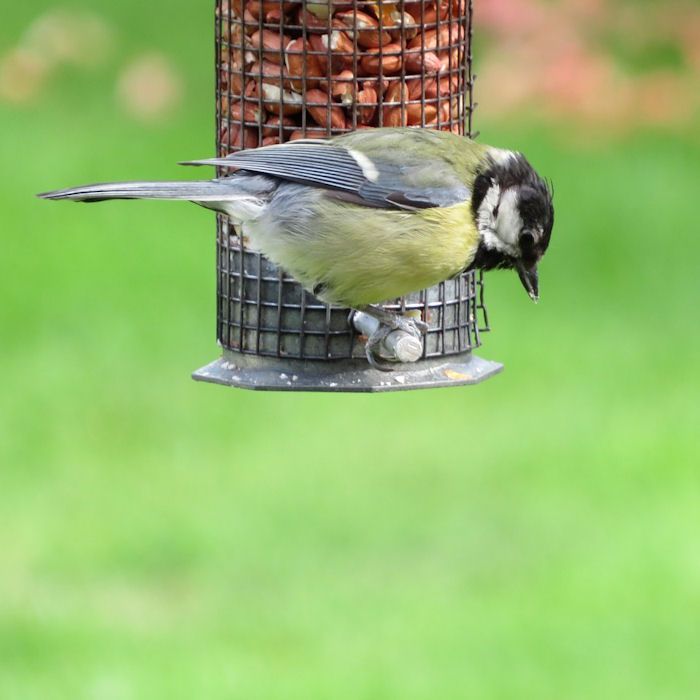
Peanuts are loved by the biggest crop of small garden birds in the UK, so its any wonder why bird lovers always have a peanut bird feeder in there garden at any one time.
Small birds likely to feed on this one include: Blue Tits, Coal Tits, Marsh Tits, Willow Tits, Green-Grey headed or Great Spotted Woodpecker. It also possible to receive unwanted visitation by Crows and Raven, though you might want to make exception for the beautiful Jackdaws if they show up.
Peanuts are much loved by birds which is why they are designed in long metal mesh feeders, so as many birds as possible can feed at one time, and its probably the reason why they get so noisy at feeding times.
If you have a squirrel problem, then you could get a squirrel proof bird feeder for peanuts only. It would be best to go for a peanut feeder with cage attached already, but often the manufacturer will allow you to buy compatible accessories if you need it later.
Should be identical but they're not, peanut/nut feeders very differently. If you have mixed wild bird nuts that are not peanuts, then the feeders are smaller, shorter and often wider.
Though you should get away with using the same feeder for both peanuts and other nuts.
3) Fat ball feeder
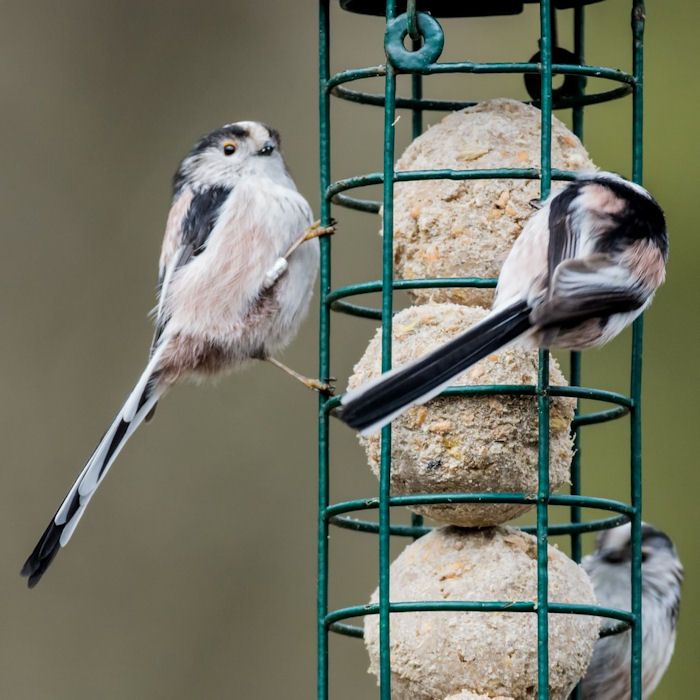
Particularly useful for winter feeding birds building up fat, but is an absolute favourite with all types of birds, all year round.
And that's the reason they always come with pole feeding stations.
Large, open wired mesh design allows for feeding through open gaps, offering all types of birds to feed; including Blue Tits, Coal Tits, Great Tits, Long-tail Tits, Great Spotted Woodpecker, Robins, sparrows and Starlings - we can't list them all but there's so many more.
Designed to take up to six fat balls at a time, so these feeders are quite short as fat balls pile up on top of one another.
If you're using a fat ball feeder now or one later, then you should be thinking about buying bulk with loose fat balls for you to fill up the feeder specially.
Remember fat balls come in those nasty - bad for the environment - green netting which can be hung or sat anywhere, well the use of a fat ball feeder promotes using only the fall balls by the bucket load.
4) Seed feeder
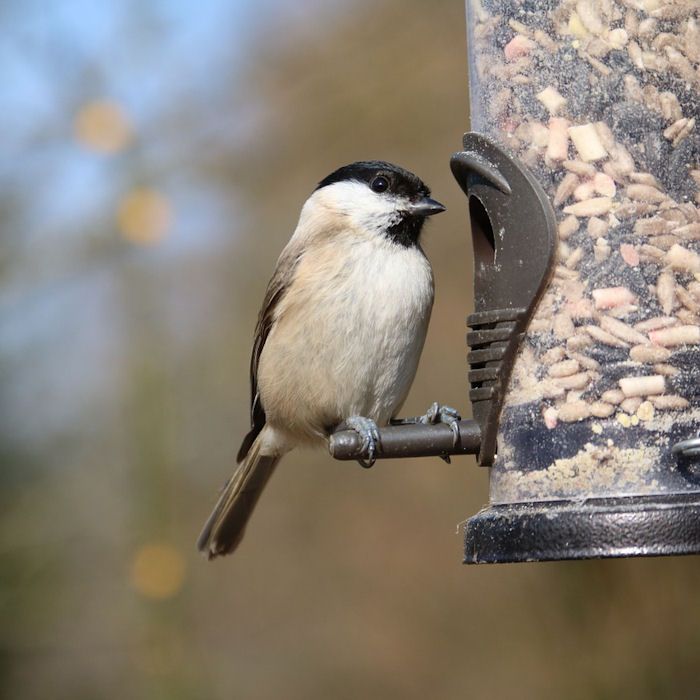
Seed feeders are made in a long or short rounded clear plastic tube with two to six bird perches to feed, with often metal hooks that would allow for withstanding the heavy weight of the loaded up bird seed feeder.
If we were to recommend a brand, then Gardman bird seed feeders would be the ones to go far. They offer a large range well shorter ones only need a small quantity of seeds.
And this is important why?
If you don't fill up seed bird feeders pass the recommended level with perches positioned higher up, then the birds won't be able to eat. Whereas seed feeders with perches at the bottom are ideal to guarantee a constant supply.
Suitable for both Nyjer or sunflower seeds - or a mixture of all types, bird feeders for seeds are one of the most used hanging feeders in the garden; liked by sparrows and Chaffinch, among all other small garden birds that won't normally eat seeds.
5) Mesh tray - hanging or fixed
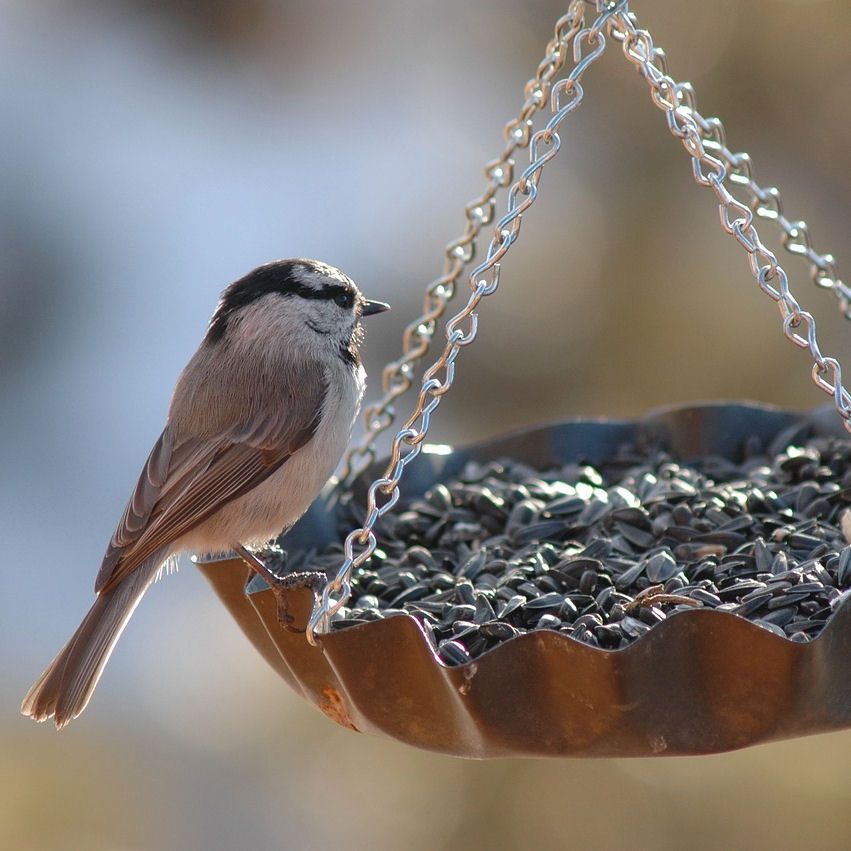
Not only can you buy purpose made bird trays for use on there own, but you will often see the mesh design used with trays on bird feeding pole stations and ground bird feeders.
Benefits to mesh trays is the chance to use it with all types of bird feed, with the exception of seeds. Then with the mesh design the water or any liquid will simply pass through.
Also this mesh base will make it easy to scrub to give it a good clean.
Sited anywhere if its an hanging bird tray, well a fixed one would need to be attached by drilling a bracket to the wall or fence post.
With hanging tray feeders they often have four points for hanging - with use of metal chain links - to help steady the tray in high winds or prevent it spinning around well birds are trying to feed.
Its quite possible all birds would attempt to feed off this one, from Blue Tits to Robins, sparrows to even the occasional Raven or Crow.
6) Ground feeder
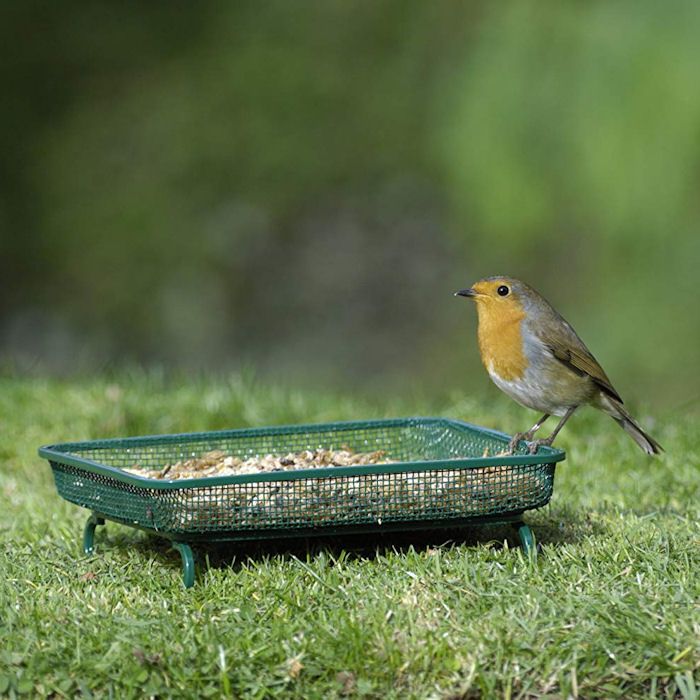
No limits to the type of wild bird that will feed at the ground feeder, though we have it listed at sixth place for good reason, but it shouldn't be an issue if you don't have a cat problem.
You see with ground bird feeders so low to the ground, wild birds become ever more vulnerable to predators, even more so as cats begin to notice them regularly feeding on ground feeders over time.
If that is an issue for you, then position the feeder on your patio or decking close to the house to give yourself time to scare them away.
Designed in wood or metal with always a mesh base for water and liquid to pass through, it does not sit directly on the ground but made with legs that sit from one to three or four inches high.
And it would always have a lip or surround where the birds perch to eat.
It will attract all types of birds; from Thrushes, Blackbirds to Crows and Ravens, to more desirable birds from Donnucks, Robins and occasional Tits.
No limit to the type of bird feed; use it for peanuts or mealworms; though you will find the mesh design doesn't allow for seeds - as they will drop through the tiny gaps.
7) Water, feed combo
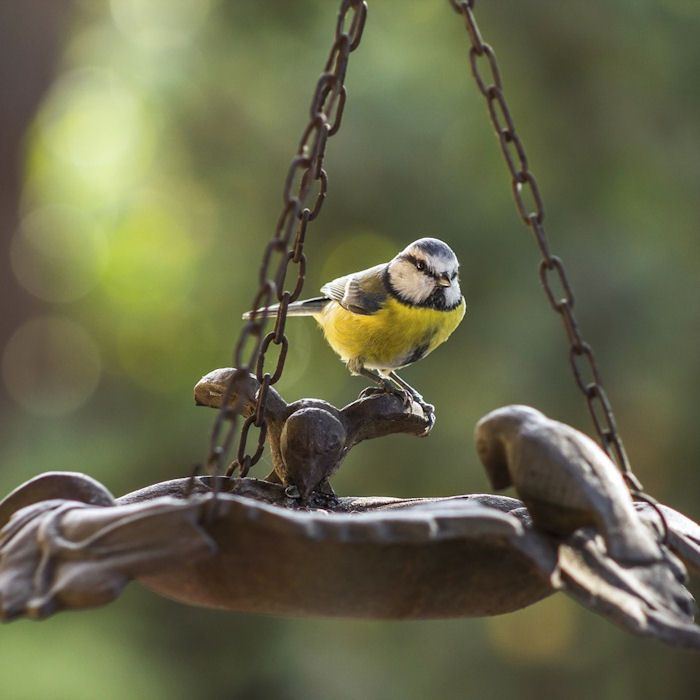
Probably more leaning towards a bird bath than a bird feeder, but its not usually possible to offer both water and food at the same time.
We might be right to say you have a solid number of bird feeders already, so with that in mind, keep this feeder for water only.
But what are we talking about? A water/feed combination refers to either a bracket or hanging feeding tray. Its made from plastic to take on water but not made with a mesh base as it won't be suitable for water.
And it would appear like a feeding dish where birds perch around the edge.
Unlike bird feeding trays that are always made from mesh, the water and feed combo can be used for both options with no leaking.
8) Feeder for suet cakes/blocks
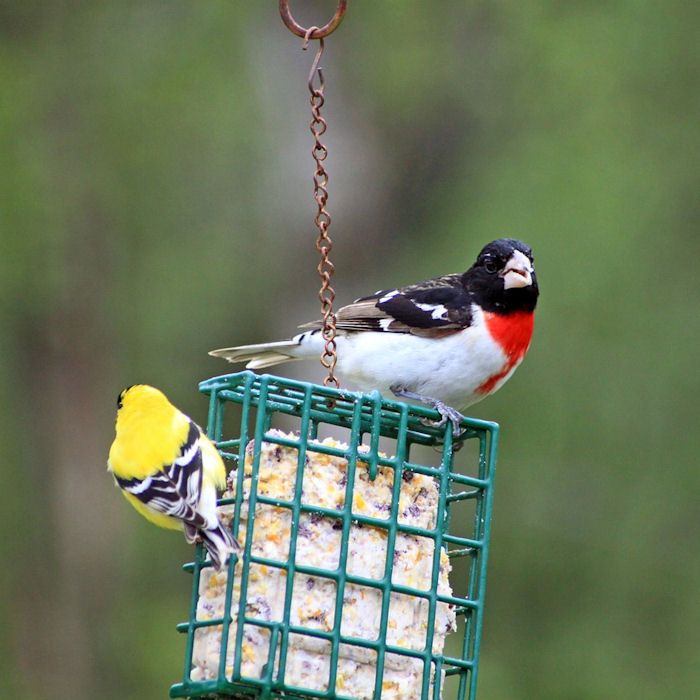
People would often prefer to feed wild birds fat balls than go for the trouble of buying suet cakes for specialty suet block bird feeders, with suet cakes not as widely available, but still messy as fat balls.
Suet feeders can be wrapped around a small tree or fixed to a wall or fence post, but more often they're made to be hanged off your feeding station pole which seems to the choice by many.
Connected to the suet feeder is a metal link chain, which would often match the feeder design, and would be fixed to the hatch you insert the suet through.
They're made in a metal wired mesh-like cage where the wild birds - same ones that eat fat balls - can cling on to feed through the square openings.
If you get any success, likely eaters at the suet cake feeder are Jays, Woodpeckers and sparrows - though more likely than not you will see the common Tits and sparrows.
9) Window feeder
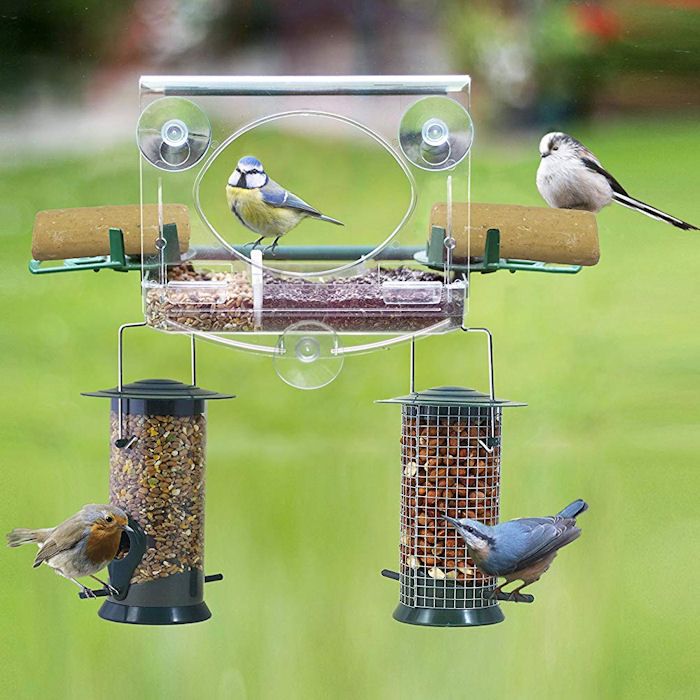
Much as they are attractive to buy to get an up close and personal view of wild birds feeding outside of your window, it might not be always possible and would be less successful than most common feeders.
That reason alone is why its not a priority feeder to us, and should only be considered if you get lots off small garden birds close to your window already.
In buying a window bird feeder, try to make it a Meripac one, as they've been making such feeders for a long time, well producing a nice range.
What you should be looking out for when buying a window bird feeder is one with at least three window suctions, the more there is the less likely the feeder will become unstuck - but it shouldn't be much of an issue anyway.
Bird food you should be using on this window feeder should be of a small quantity to prevent it getting to heavy - which it will with more birds joining in.
So for that reason leave it to just a small drop of peanuts or seeds, and if there're compartments, then use both.
That's not to say you can't use a couple of fat balls or a pile of mealworms, in fact most feed will attract small birds to the window.
10) Hanging bird feeding table
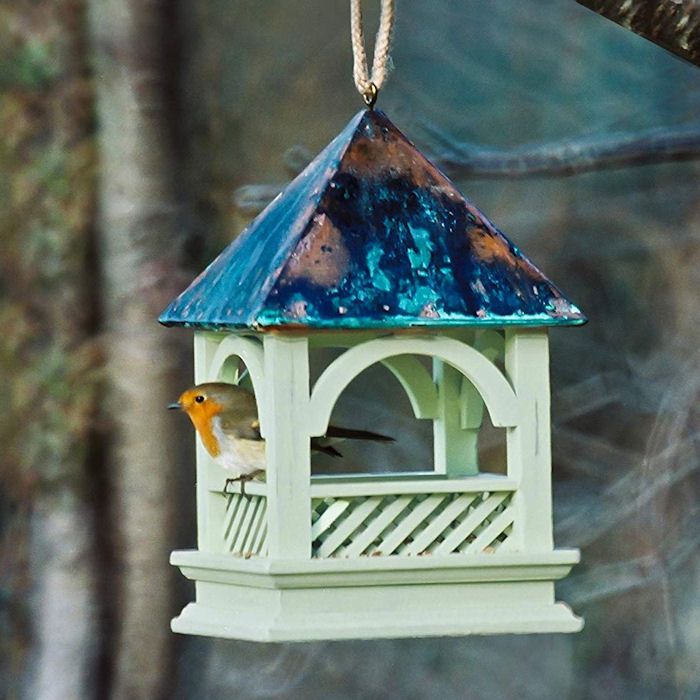
No restrictions or limitations with a hanging bird feeding table, in fact the only thing you have to do is find the perfect spot.
Not really suitable for hanging off the multiple bird feeding station, but should rather be hung up all by itself; such as a wall bracket or fence post or tree.
Fixed to hanging bird feeders is the rope you hook over; which is usually designed to compliment the feeder in question (as pictured), and will blend in nicely.
The feeding table we're talking about are those ones with an roof, and a large surface to serve up all types of bird food, which is easily washable.
But as its so far down the list, and not quite one of the best bird feeders is due to the design being quite heavy, bulky with limitation where it would fit in most garden.
Food should not be exposed to large belts of rain fall as it would be come soggy and turn to mush, and the birds won't like that, so at least you benefit here.
Primarily made from natural wood, it could be modern or antique looking, the edges that act as perches could be simple, but also decorated and little complex for birds, furthermore would go towards ruining your view of birds feeding.
11) Wooden bird table
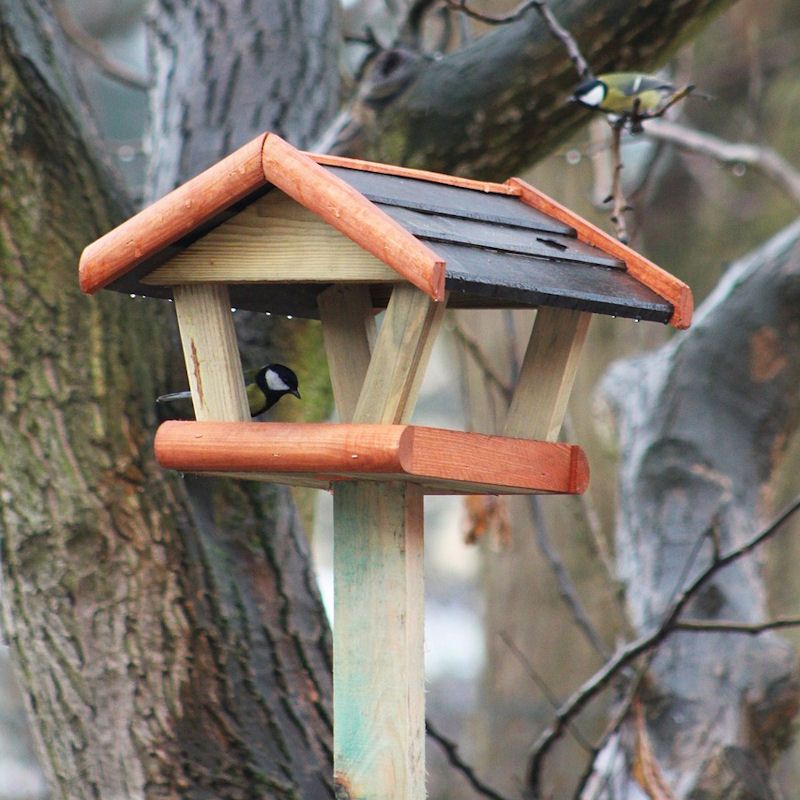
Attractive, naturally blending in to its surroundings, wooden bird tables are suitable for larger gardens due to there size; which are usually handcrafted for garden centres and farm shops.
If you find yourself with a small garden but wish to use a wooden bird table on a post, then there're a large selection for you in smaller sizes.
However, what are popular right now are hanging wooden bird tables that have roof to keep the rain off the food (as we've mentioned above), with an option to hang it anywhere you have a good spot in the garden.
That could be a tree branch, fence post, or people's favourite; hanging off the bracket attached to the house brick wall.
Here we've suggested the bird table on a post because its that feature that makes it easy to position anywhere, helped with a four leg base that keeps it standing up.
However, this post function that might also put people off, due to balancing issues which might require you to buy stabilisers, and that feature only works if you've positioned it on the lawn. If you only have a patio or decking, you'll be in trouble.
And well this is a preferred build for most, unless you don't mind the table weathering over the years, then it is troublesome to keep maintaining the table once a year with preservative and a new splash of paint or stain.
12) Mealworm feeder
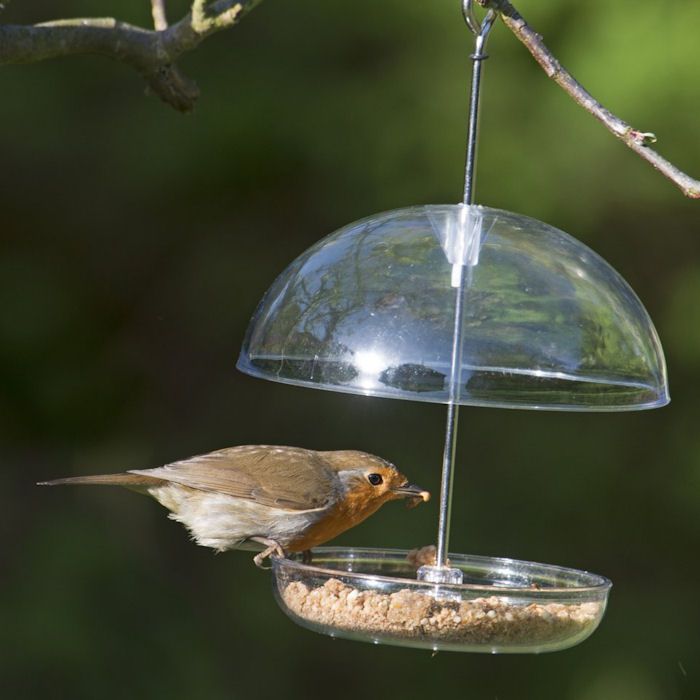
Finding it self down the list are tube feeders for dried mealworms, and well not always necessary; mealworm eating birds would normal prefer to eat them off the ground, as they would insects.
So for that reason alone, less priority should be put on buying a bird feeder for mealworms but should still work at the feeding station.
If you have mealworms, throw them on the ground to see if that works when compared to filling up the mealworm feeder - though the open feeding tray will be the best option - which we consider the firth most important feeder.
Similar to a clear tube seed feeder with a larger feed opening, the best mealworm feeders will retain the dryness of mealworms until birds are ready to eat them - with a tray to catch any that drop.
Something different to the hanging tube feeder is a covered, clear (pictured) or mesh tray feeder which is not as restrictive as the tube design.
Birds that might be attracted to the mealworms are starlings and sparrows, with the Robin the most interested of all.
13) Peanut butter feeder
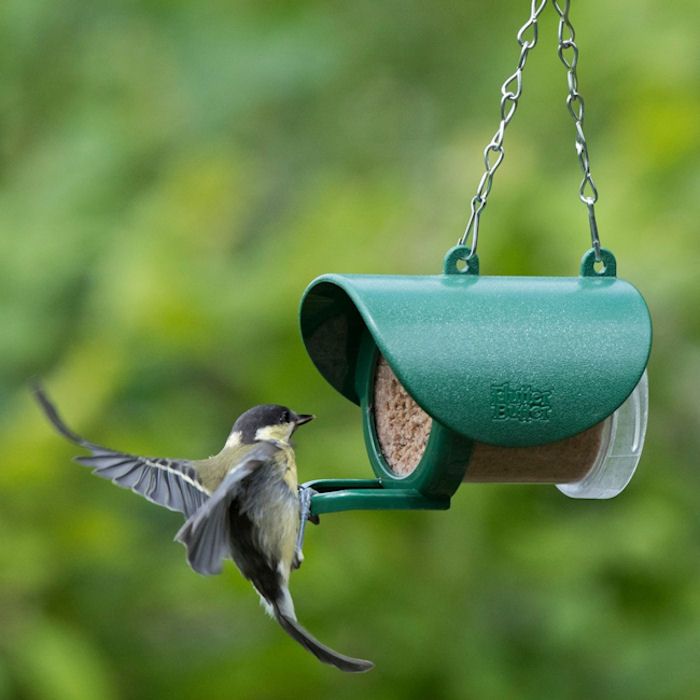
Not something we use as often in the UK, but did you know you can feed jars of open peanut butter to wild birds.
Its not the full fat, full of sugar and salt people would normall consume, this is special formulated peanut butter to feed to wild birds.
Often the jar would be the same size and design, so the peanut butter feeder is always compatible with a multitude of brands.
Well its possible to lay a peanut butter jar on its side without use of the feeder, know that when the feeder is sited up high on the fence post or brick wall, the birds are up high out of the way and safe.
So well we consider a peanut butter feeder less important than any other types of bird feeders, it is sure to attract an assortment of common garden birds; Blue Tits, Coal Tits, Robins and Sparrows might give it a go, more so if you have a wider variety of birds in your garden.
Made from wood with a simple pointed roof, they also come made in plastic with usually have a perch for the 'tipped to the side' peanut butter jar or plastic container, with or without a system that locks the jar in place.
Conclusion
So we've only listed the best bird feeders, being realistic on whether they actually work all year round, or even work at all.
When buying a bird feeder it would be ideal to get an all in one feeding station, as you get all the top hanging feeders including.
Well the pole digs into the lawn, this will get you setup instantly
Our list then takes into consideration mostly individual bird feeders that are likely to attract the most common types of birds to eat at the feeder; with the peanut, seed and fat ball feeders the highest chances of birds feeding, so therefore the best of the lot.
